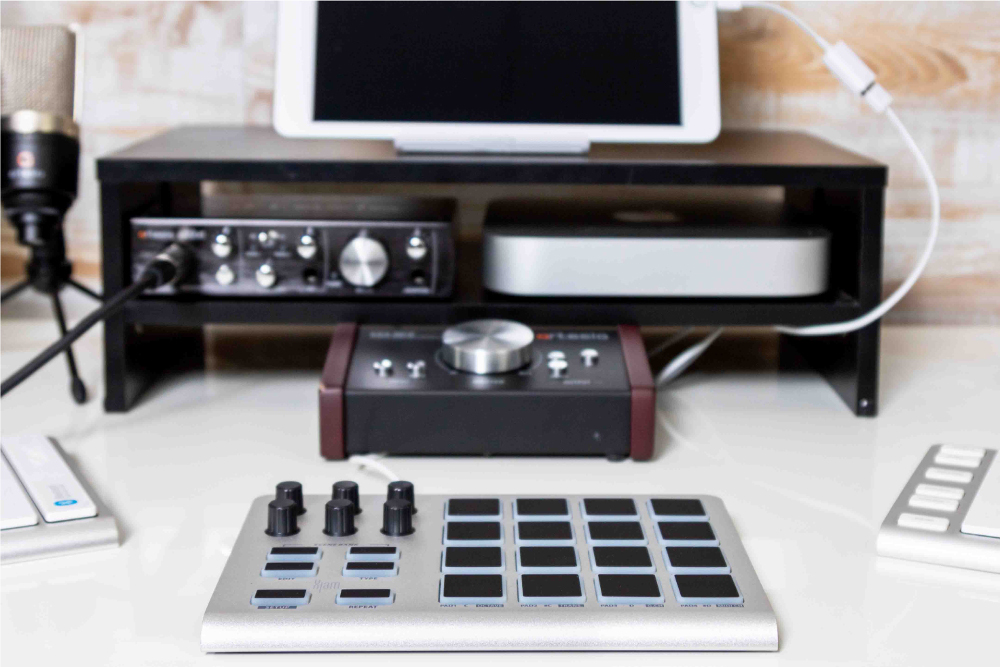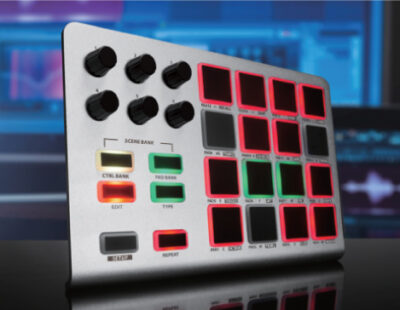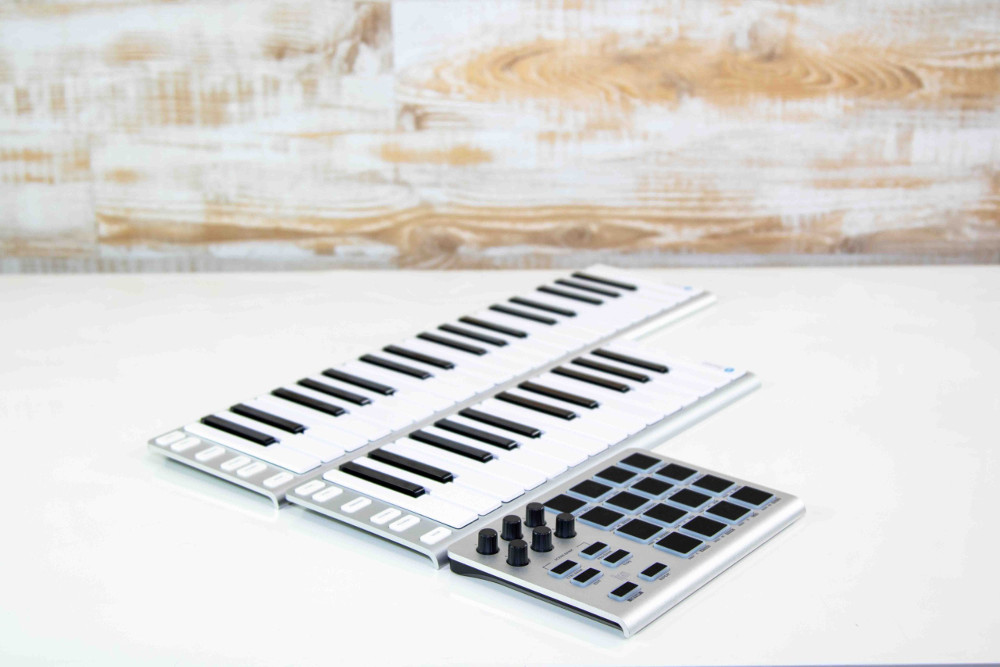New Gear Review: Xjam Mobile Pad Controller by Artesia
Artesia Pro have followed up from their XKey, a beautifully built controller keyboard whose compact footprint mimics your standard Apple keyboard. Their new Xjam mobile pad controller is also similar in size and aesthetic, down to its burnished aluminum housing.
A USB-powered pad controller, the Xjam is equally compatible with desktop and mobile devices. This makes it useful for studio, live, or on-the-road creating, allowing flexible control with a minimum footprint to fit comfortably both on your desk and in your luggage.
Features
The Xjam has features you’d typically expect from a pad controller, but has a few nicely implemented features that make it stand out, aside from its ultra convenient size.
First let’s talk about the physical aspects. This device is small, but not too small. It’s Goldilocks: just right. It feels comfortable enough to work and perform, but not obtrusive in its presence.
Xjam has 16 pressure-sensitive pads with trim-color LEDS & velocity aftertouch. There is one pad bank button, also tricolor LED, to switch between three independent pad banks. Next there is also a bank button, with the tricolor LED to switch between three independent banks for the pots.
The edit button (which has a single LED for each pad or encoder to change the note number value or CC value) is very useful and carefully placed.
Note Repeat is just within reach to allow On/Off of six encoders, allowing you to send continuous controller messages. On the back side of the controller there are even MIDI out and footswitch ports, for more flexibility during writing or performance.
You can recall up to 48 settings, making the Xjam incredibly flexible, along with the clock source being both internal and external. It ships with a USB cable and quick start guide, but beyond the standard accessories there are even included licenses from Bitwig Studio, WaveLabLE10 and Cubasis LE3 (for mobile devices!).
In Use
I started with mobile applications first, as I wanted to see how it would be to work while traveling. So I connected Xjam with my iPad Pro and began hunting around for different applications and synths that I could expressively interact with.
With Cubasis LE3 you have an accessible drawing pad to start from for song ideas, and I found that the Xjam worked with some of my favorite mobile synths like Reason Compact, Animoog Z, plus coming with Cubasis LE3 you have a lot just to start with.
I would recommend keeping two things in mind: First, it helps to download their Xjam Editor app from the app store beforehand. This will help you for some fine tuning of your Xjam, and also usefully links to the online user guide for quick reference.
You’ll also need some sort of USB hub, because while it’s buss-powered, it is NOT micro USB to your mobile device, but a standard USB. So if you are really planning on using this on the go, don’t forget to grab one of those, otherwise it will be inaccessible. (More thoughts on this later…)
You’ll have to be prepared for some level of trial and error on mobile applications to find out which ones work immediately, which ones require some setup, and which ones aren’t compatible at all.
To really get the full flexibility of some of these applications I would recommend using them in conjunction with the Xkey, so that you could have the combined functionality of both (or any other keyboard-style controller that you may have for portable/live use.)
For example, playing a keyboard part is possible on the Xjam, but is notably more intuitive on a traditional keyboard style- controller, for some elements of performance and instrumentation. Since the Xjam has pots, you could use those to control the parameters of your instrument from there.
Setup is pretty easy, especially if you’re used to working with controllers and MIDI mapping.
On desktop I gave it a spin with Ableton, and was pleased to find that a lot of my samples automated immediately , providing expressive touch-sensitive pads with aftertouch. So not only were drums now more tactile, but also any other samples that I had that were pitched, (as well as pitched drums!) This is useful for more dynamic input and performance.
It would be interesting to see an updated list of supported DAWs and mobile applications on their site, to help guide some of these initial explorations. Ableton integrated with it no problem as does the included BitWig Studio and WavelabLE10. I could definitely see this being a game changer for anyone looking to have a smaller footprint in their desktop workflow. For example, Xjam would be ideal for incorporating a pad controller to live perform drum parts, in addition to other percussive and manipulated elements.
To Be Critical
The obvious pain point to me has to be the lack of Bluetooth. I know that their Xkey has connectivity via either 4.0 Bluetooth or USB cable models, and I had hoped that they would take this design idea one step further and include it in the XJam.
Taking that one step further, I would also have liked to have seen them update to the latest type of USB connection (USB C) since Xjam requires a hub when working with mobile devices, but it is still accessible enough from most desktops and laptops… if you still have a classic USB port.
Having a Bluetooth feature that I could toggle on and off would allow it to passively charge while in USB mode, plus a switch to turn on the Bluetooth — clearing my desktop of a messy cable, and thus freeing the port.
This is really pretty essential in mobile use for the reasons stated above. Mobile test trials were tricky for me because my iPad hub extension doesn’t allow for more than one classic USB device at a time. As a result, I couldn’t try out use cases for both Xkey and Xjam at the same time, as it was one or the other. (Although Xkey does come in Bluetooth model, so I highly suggest if you want to use both together get the Bluetooth Xkey!)
You can use the Xjam to control a virtual synth, in terms of playing the parts in through the pads, but I found it difficult, and I wouldn’t recommend it. Even though there is the ability for a foot pedal (which I did not test), I found it very difficult to trigger a harder/louder velocity when playing a keyboard-styled part, and in general I think that the XJam is better suited to parts that are going to be percussively played in, or parts that are less dependent on expressive dynamics. You really have to press harder get the pad to light up red, indicating a louder velocity. However, pairing your Xjam with an XKey or any other portable keyboard controller would negate this issue.
Having the pots on the XJam does offer some physical access to things like filter sweeps etc…, which is far better than trying to mouse these nuances in on screen, in any application, mobile or not.
Summing Up
Priced at $139, Xjam is a solid buy for music makers on the go, whether writing is something you need to do while traveling, or you are looking to keep your live act as light as possible (who doesn’t need that?).You may also be looking for a desktop controller that takes up very little real estate. Xjam offers an affordable and dynamic solution for both needs.
The bundled software makes this a great student friendly option for those starting out and looking to have software and hardware that are dorm room-sized. Pros and students alike will surely enjoy the sleek design and expressive , flexible features of this controller, making drum programing, live performance, and mobile creation all the more within reach.
— Kallie Marie is a contributor to SonicScoop.com. She is the author of “Conversations with Women in Music Production“, available now from Backbeat Books.
Please note: When you buy products through links on this page, we may earn an affiliate commission.











[…] Source link […]